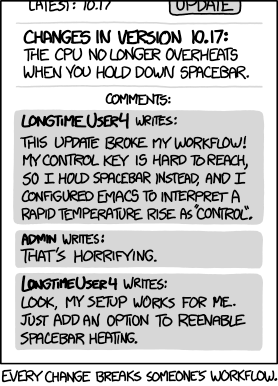I’ve some weeks ago moved my main computer from Windows 10 to Linux, specifically OpenSUSE Leap with the Plasma user environment, mainly because it doesn’t have the magic Windows 11 chip. I had never used Linux and have been a Windows user since I was six years old or somewhere around then (I’m in my late twenties now). I’d just like to share my likes and dislikes.
Things I like about Linux (my specific install, anyway):
- Not being a corporate environment. There aren’t any cheeky attempts at making money or advertisement anywhere, like the annoying fake widgets in Windows 11 and the half-filled start menu. I’ve gotten used to that on my laptop (which is running 11), but you do always have the feeling of ‘what are they trying now?’ That not being a thing is quite refreshing.
- In that veign, having actual widgets. I loved them in Windows 7; I’ve got a webpage widget on my second screen showing a Zoho sheet I made with an RSS feed. Just being able to be a bit creative like that is cool.
- The system seems quite a bit quicker than it was in Windows - though in all honesty this will also be because I’m still on a fairly fresh install.
- I’m positively surprised by how little I miss from Windows when it comes to programs. Steam having compatibility tools is great, for example. Otherwise there are often replacements for what I’m missing (eg. I’ve found one to allow general settings for my Logitech mouse).
- The general ability to change the way everything looks and feels. I feel technical people sometimes look down a bit on aesthetics, but I really care about the user interface I use day in day out looking and feeling nice. While I’m a fan of the Windows 11 look myself, I really like how much I’ve been able to get my UI to look how I want it to in Plasma. Though I’m a bit surprised that it’s so hard to change the appearance of the start menu and bottom panel. I’ve had to install a specific program to change their colouring.
- The little icon jumping next to your cursor when opening a program (I know, I’m easily amused).
Things I’ve found annoying:
- Not knowing where to find anything. Of course, coming from Windows I’m used to there being a program files folder with my programs’ folders, and a documents folder with (often) user settings for those programs. In Linux, everything just seems to be everywhere. What seems to be the ‘documents’ equivalent for the game Factorio is in my user folder in a hidden .factorio, but I’ve to no avail been trying to find out where my ‘documents’ for Workers and Resources are. I’ll find them eventually, I’m sure. In general, I’m looking around a lot, though.
- The lingering feeling of instability. This is my second install of OpenSUSE, after I messed up something leading to my computer having some files which it wanted to update, but using urls which didn’t exist. After this, I’ve been feeling a bit insecure and afraid of doing something that ruins my installation. I know there’s the saying that Linux ‘just works’, but I’ve never messed up a Windows installation…
- The capslock works differently, apparently. I’m used to writing every capital letter using the capslock key, meaning if I write a capital at the beginning of a word, I press capslock, then type the first letter, then quickly press capslock again and type the rest. In Linux, this often doesn’t work as it somehow takes a while for the capslock press to go into effect, so you often end up with ‘LInux’, for example. After lots of looking around, I have found some script that seems to fix this (‘Linux CapsLock Delay Fixer Master’), but it also randomly stops working and there are other ‘oddities’ I can’t really explain.
- Every once in a while, my desktop icons get rearranged. This seems to be a known issue, but it’s really annoying.
- It seems impossible to get Firefox to not restore sessions after shutting down the computer with it still open. I’ve tried several things, but I can’t get Firefox to just give me a fresh session on startup.
- The above all add to a bit of a general ‘stuck together with adhesive tape and love’ feeling.
- Not knowing how to install programs. This is more of a learning-curve thing, obviously. The software centre didn’t contain everything I could find online - for some programs, you could use ‘one click’ in OpenSUSE, but that seems to work more like a self-destruct button: I’ve tried those several times and have always had bad results >.>. I’ve found it’s easiest to install programs just using flatpaks.
All in all, I am quite happy. Though I am still afraid I’ll mess up my installation, and I’m now at a point where that’d hurt. I have installed Timeshift, but also with mixed results…
The capslock works differently, apparently. I’m used to writing every capital letter using the capslock key, meaning if I write a capital at the beginning of a word, I press capslock, then type the first letter, then quickly press capslock again and type the rest.

Pressing caps lock for a single capital letter should be outlawed or be painful or something. That’s just weird.
I agree, but it’s more common than you’d think.
I used to work at an organization that used Chromebooks, which replaces the caps lock key with a search key (same shape, different behaviour). I was surprised at the number of people who struggled with their passwords because they would hit the “search” key, enter a single letter, and then hit “search” again. It took me a little while to figure it out because… Who does that?
My sister hated me for it when I was ten, it gives me warm feelings :p
🤣
Welcome to Linux. You’ll learn, and for the better, by using it more. Like picking up anything new there will be difficulties at times, but well worth it. The first positive on your list is good enough reason that makes any difficulties worth surpassing.
My first positive is first for a reason, indeed :)
- Can’t find anything: everything is meant to be searchable in lieu of having a programs menu and such. Hit your meta key (Winkey) and start typing to find or launch something, use URL bar in your file manager to search for names or content of files…etc. You can also just set icons for things if you wish.
- Instability: there is almost zero chance of you being able to destroy your environment so bad that it would require a reinstall of the OS. Since it’s just flat files on a disk and no central registry like Windows, everything can be repaired quite simply, you just need to be familiar with how.
- Capslock: unfamiliar with your intended behavior as I’ve never used Capslock like that before, but I bet there is a solution for this if you just search around. Input behavior is totally customizable.
- Desktop icons: no idea what that could be, but as mentioned above, most DE’s have or are moving away from desktop as a launch source.
- Firefox: ‘about:config’ has these settings
- Software center is just one GUI for finding things. You can install whatever you want however you want, and that’s just up to you. If you find some piece of something you want to run, the preferred method is also using a package for your OS’s package manager, but that’s just for convenience and not a hard rule. There is no “best” solution, just good habits.
Good luck!
Instability: there is almost zero chance of you being able to destroy your environment so bad that it would require a reinstall of the OS. Since it’s just flat files on a disk and no central registry like Windows, everything can be repaired quite simply, you just need to be familiar with how.
Yeah, but I spent half a day faffing about trying to see what I’d done wrong and searching online for hints. I suppose I didn’t literally ruin my installation, but I’d messed it up enough for me to not know how to fix it, so I gave up.
Firefox: ‘about:config’ has these settings
That’s the first thing you find online, pretty much. Changing settings in about:config doesn’t work (in this case), and I’ve followed instructions involving adding an autoconfig.cfg file to the Firefox installation folder, which also didn’t work. But yeah, like I said, I tried some things and have not been able to get Firefox to start a fresh session on startup, after shutting down the computer with it still open.
Thanks for the advice!
I will answer to your annoyances from my context: I use Bazzite on my gaming rig and Aurora on my work laptop.
-
I only use Flatpaks for GUI apps and Homebrew for CLI apps, things are stored in their respective folders.
-
My chosen distros are atomic / immutable, only user files can be changed, the system is shielded from breakage. You just can’t brick it unless you really want to.
-
Caps lock works the same as windows.
-
Desktop shortcuts rearranging, didn’t happen to me / haven’t noticed.
-
Firefox restoring session no matter what: I’ll try that and get back to you.
-
Bazzite & Aurora are very polished.
-
Flatpaks are the best, for CLI apps I use homebrew.
-
Bazzite / Aurora have automatically generated rollback images.
Honestly, if you want something that works for you and not the other way around, I suggest you use an Universal Blue distro.
Caps lock works the same as windows.
Capslock definitely doesn’t work the same as in Windows. If it did, I wouldn’t need to run a weird script to get it to behave like how I’m used to after more than twenty years of using Windows. I’m not the only one with this problem either (this is actually exactly the reason why someone went and made said script), nor is it only present in OpenSUSE. I’ve read it’s a general Linux thing, and I can at least say it’s on Mint as well. Interestingly (though unrelatedly) on Samsung Dex as well.
Another difference in behavior I’ve noticed is that in Windows, if you press capslock to turn it off, it does so upon pressing the key. In Linux, it does so only after releasing the key. Pretty weird.
Firefox restoring session no matter what: I’ll try that and get back to you.
No need, ikidd@lemmy.world suggested deinstalling the default Firefox installation and then installing it as a flatpak; this fixed the issue.
Regarding Caps Lock, the user named “warmaster” only relayed their own experiences. FWIW, I can relate to their experience. Ever since my switch from Windows to Fedora Silverblue, I haven’t experienced any difference in Caps Lock functionality; it’s literally the same as I was used to on Windows. And thus the very same you* said you liked. My repertoire of distros ain’t as impressive as some notorious distro-hoppers. However, I don’t recall this to be different on Arch, EndeavourOS, Nobara or other images within the Fedora Atomic ecosystem.
Edit: added “you”
Fair enough.
He’s right. As I stated at the beginning of my comment, I was only speaking about Bazzite and Aurora, I wholeheartedly recommend you try them.
-
The lingering feeling of instability. This is my second install of OpenSUSE, after I messed up something leading to my computer having some files which it wanted to update, but using urls which didn’t exist. After this, I’ve been feeling a bit insecure and afraid of doing something that ruins my installation. I know there’s the saying that Linux ‘just works’, but I’ve never messed up a Windows installation…
Regarding this. How often did you mess your windows installation when you started? Because I started around 8 years old with MSDOS and I screwed Windows many times, eventually I learnt what to do and what not.
Regarding software today it’s easier than it’s ever been in Linux. With flatpack, appimages and the different repos.
Anyway there is this scene in the show “Bojack Horseman” where the titular character was trying to do some exercise by running up a hill and he is tired, exhausted, another characters pass by and says: “It gets easier”, “uh?” answers Bojack, “It gets easier but you have to do it every day, that’s the hard part”.
What that means is, it will get easier, specially when you are young, but you have to be constant, you have to keep messing around and do backups.
That being said, I am huge fan of opensuse and debian but eventually on my desktop I went with endeavour-os, the only time I screwed it up it was easy to fix it by using the live-iso editing the config files and fixed, now I keep a journal when I change anything :)

No workee?
That’s turned off, yes.
If you try installing the flatpak version of FF rather than using the zypper version, does that work better? I’m not too familiar with OpenSUSE, but that seems like a problem with the packaging.
Interesting idea. I’ll give that a shot soon.
Yah, it sounds like a quirk. I kinda like it reopening my tabs, but I just tried it on the stock FF in a fresh Fedora KDE install and it works fine.
It seems to have done the trick, cheers! I do get the ‘Your Firefox session has closed unexpectedly, do you want to recover it?’ screen, but I read earlier that Firefox on Linux indeed thinks it has crashed when it’s not closed the ‘proper’ way, which is by closing it from the menu. It doesn’t do this on Windows, which is really odd. But I should be able to just turn off that screen in about:config. Perfect.
As a first linux I’d suggest Mint, not suse or anything else. I’m a debian-testing user myself (rolling release), but for new users, use mint. All the problems you mention don’t happen on mint.
Yeah, I first tried Mint, but I didn’t like the look and feel of Cinnamon. It felt a bit cheap for my taste.
By the way, the capslock issue is certainly also true on Mint (but I’m afraid I’m not allowed to complain about that here :p )
I find the looks of Cinnamon just fine with a bit of optimization, eg… using the new theme and using cinnamenu instead of the default menu. Here’s mine: https://files.mastodon.social/media_attachments/files/113/537/970/191/106/160/original/2bfb19edd50e248f.jpg What i like from mint is that it’s clean looking.
I’m going more for a mix between Windows 7 and 11 with more colour:

Also if you have a spare hard drive laying around you could use timeshift to snapshot your install with an easy restore method to give you some confort
First and foremost, welcome to Linux!
Few pointers to hopefully help the process :
- “Not knowing where to find anything.” indeed, it’s disorienting but it will come. You can find actual “maps” but honestly, just as you would do in other operating system, use the search function. If it’s not obvious this way, search online. The first few times it will be weird then each time it does become easier until it actually makes sense!
- “The lingering feeling of instability.” have a /home directory (not “folder”, that’s funnily enough a Windows term as they tried to be different, going from the unanimously used
/to their ownC:\things) so that you can actually go “nuts” with your installation, actually messing things up but without the fear of losing your precious data! Each new install is an occasion to learn. That being said, Linux is very VERY stable. I’ve been running the same installation for years, on desktop and servers alike. If something goes wrong it can usually be fixed and it’s, again, an occasion to learn. That being said, having a dedicated/homedirectory on its own partition or even disk gives you the opportunity for a low effort low risk blank slate. - “The capslock works differently” … well this one is quick, you’re looking for the SHIFT key if you only want to type few characters in uppercase ;)
- “Every once in a while, my desktop icons get rearranged.” yet another occasion to learn. What’s the bug from? Is there an issue open? Is it being worked on? By whom? How? Why? You might even be able to fix it!
- “It seems impossible to get Firefox to not restore sessions after shutting down the computer with it still open.” it’s in the Firefox preference : Settings -> Startup -> untick “Open previous windows and tabs”, literally the first option.
- “The above all add to a bit of a general ‘stuck together with adhesive tape and love’ feeling.” nice, and that’s just the surface, it’s now YOUR system so you can do whatever you want, even if everybody else disagree.
- “Not knowing how to install programs.” well that loops back to all the learning opportunities above and the last remark, it’s YOUR system so you can use whatever you prefer, both in terms of apps, settings or even how to install (or not! Check e.g. Nix) apps. There are even “weirder” things like https://github.com/ivan-hc/AM but the point is, you decide, again, always!
To clarify, I’ve been using Linux for decades… and I still take notes! For example https://fabien.benetou.fr/Tools/Shell or https://fabien.benetou.fr/Tools/Ffmpeg so please, pretty please, do NOT keep it all in your head! There are myriads of way to record your learning so don’t be shy about it.
Oh yeah same here, I’ve been using Linux in some form or another since maybe 2006 or so, and I still have a folder in Obsidian that’s just notes about Linux lol. Usually if I customize something or fix something or learn something new, I’ll chuck it in the notes along with the link to where I found it so I don’t have to retrace my steps looking for it again.
Not knowing where to find anything.
man, try info too. But linux might not have good man page, so use the wiki too.
For backing up my home folder, I just plug in my external drive and use rsync from the terminal, like so (change to your user name; mine is gecko. Double check the paths and edit as necessary)
rsync -av /home/gecko/ /media/gecko/media/emmahomebackup/ --delete --dry-run(test first, check for errors at the end of output, there shouldn’t be any unless you messed up the paths)then,
rsync -av /home/gecko/ /media/gecko/media/emmahomebackup/ --deleteThis command will back up your home folder the first time you run it, and on subsequent runs will sync any changes that have occured since the last run.
To restore, reverse the paths.
For backing up my system files (basically, everything outside of my home folder) I just use Timeshift.
I’m here, l’ll help you solve your issue.
mostly everything will be downloaded in your /home folder and apps that ask for where to save files you can tell where to save.
wait for some time ask for help don’t fresh install just because you run into some issue, ik you wanna get your work done asap but it happens to the best of us, btw you’ll learn to fix issues.
Never knew until you told me that capslock works different on linux.
try removing the panel and add new one, and if happenes again then it’s definitely a bug.
check ff settings that you’ve enabled restore previous session or open previous windows or tabs something like that and checkout firefox/tweaks
I’m not against flatpaks at all but if you have the same program/app in official repos then use package manager cuz if u use flatpaks then you’ve to mess with permission or you’ve to theme them and you’ll need apps like flatseal or warehouse to manage flatpaks.
also checkout Open Build Service (OBS) it’s for opensuse









